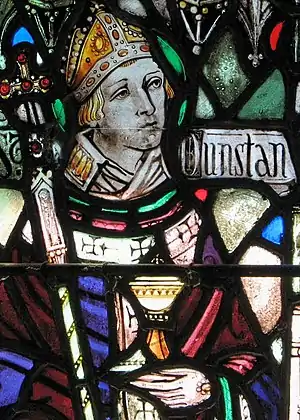956
Year 956 (CMLVI) was a leap year starting on Tuesday (link will display the full calendar) of the Julian calendar.
| Millennium: | 1st millennium |
|---|---|
| Centuries: | |
| Decades: | |
| Years: |
| 956 by topic |
|---|
| Leaders |
|
| Categories |
|
| Gregorian calendar | 956 CMLVI |
| Ab urbe condita | 1709 |
| Armenian calendar | 405 ԹՎ ՆԵ |
| Assyrian calendar | 5706 |
| Balinese saka calendar | 877–878 |
| Bengali calendar | 363 |
| Berber calendar | 1906 |
| Buddhist calendar | 1500 |
| Burmese calendar | 318 |
| Byzantine calendar | 6464–6465 |
| Chinese calendar | 乙卯年 (Wood Rabbit) 3652 or 3592 — to — 丙辰年 (Fire Dragon) 3653 or 3593 |
| Coptic calendar | 672–673 |
| Discordian calendar | 2122 |
| Ethiopian calendar | 948–949 |
| Hebrew calendar | 4716–4717 |
| Hindu calendars | |
| - Vikram Samvat | 1012–1013 |
| - Shaka Samvat | 877–878 |
| - Kali Yuga | 4056–4057 |
| Holocene calendar | 10956 |
| Iranian calendar | 334–335 |
| Islamic calendar | 344–345 |
| Japanese calendar | Tenryaku 10 (天暦10年) |
| Javanese calendar | 856–857 |
| Julian calendar | 956 CMLVI |
| Korean calendar | 3289 |
| Minguo calendar | 956 before ROC 民前956年 |
| Nanakshahi calendar | −512 |
| Seleucid era | 1267/1268 AG |
| Thai solar calendar | 1498–1499 |
| Tibetan calendar | 阴木兔年 (female Wood-Rabbit) 1082 or 701 or −71 — to — 阳火龙年 (male Fire-Dragon) 1083 or 702 or −70 |

Dunstan, archbishop of Canterbury
Events
Byzantine Empire
- Summer – Emperor Constantine VII appoints Nikephoros Phokas to commander of the Byzantine field army (Domestic of the Schools) in the East. He gives him order to prepare a campaign against the Hamdanid emir Sayf al-Dawla. Constantine makes treaties with neighbouring rulers, to seek military aid.[1]
- September - October – A Byzantine fleet under Basil Hexamilites deals a crushing defeat to the Hamdanid fleet at Tarsus in Cilicia (modern Turkey).
Europe
- Liudolf, the eldest son of King Otto I (the Great), reconciles with his father and asks again for installation as duke of Swabia. Otto refuses, but at the instigation of his uncle Bruno I (duke of Lotharingia) allows Liudolf to lead an expedition to Italy to bring the vassal Berengar of Ivrea to heel.
- Berengar of Ivrea dispatches a Lombard army under his son Adalbert II to counter Liudolf, while he guards Pavia himself. In two battles Liudolf defeats the Lombard forces and enters Pavia, there to receive the homage of the Italian nobles and clergy on behalf of Otto I.
- June 16 – Hugh the Great, count of Paris, dies at Dourdan. He is succeeded by his eldest son Hugh Capet, who is recognized as Duke of the Franks by his cousin Lothair III, king of the West Frankish Kingdom.[2]
- King Ordoño III dies at Zamora after a 5-year reign. He is succeeded by his half-brother Sancho I as ruler of León (modern Spain).
Egypt
- An earthquake badly damages the Lighthouse of Alexandria: one of the Seven Wonders of the Ancient World.
Births
- Siegfried II, count of Stade (d. 1037)
- probable
- Adalbert of Prague, Bohemian bishop (approximate date)
- Sampiro, Spanish bishop (approximate date)
Deaths
- February 15 – Su Yugui, Chinese chancellor (b. 895)
- February 27 – Theophylact, Byzantine patriarch (b. 917)
- April 8 – Gilbert, duke of Burgundy
- April 15 – Lin Yanyu, Chinese court official and eunuch
- May 19 – Robert, archbishop of Trier
- June 4 – Muhammad III of Shirvan, Muslim ruler
- June 16 – Hugh the Great, Frankish nobleman (b. 898)
- July/August – Fulbert of Cambrai, bishop[4]
- August – Ordoño III, king of León[5]
- August 29 – Fu (the Elder), Chinese empress consort
- September/October – Al-Masudi, Muslim historian and geographer[6]
- December 21 – Sun Sheng, Chinese chancellor
- December 26 – Wulfstan, archbishop of York[7]
- date unknown
- Ahmad al-Muhajir, Muslim scholar and imam (b. 873)
- Congalach Cnogba, High King of Ireland
- Gandaraditya, ruler of Chola Kingdom
- Zhao Hongyin, Chinese general
References
- Timothy Reuter (1999). The New Cambridge Medieval History, Volume III, p. 591. ISBN 978-0-521-36447-8.
- Timothy Reuter (1999). The New Cambridge Medieval History, Volume III, p. 386. ISBN 978-0-521-36447-8.
- Herbermann, Charles, ed. (1913). "St. Dunstan" Catholic Encyclopedia. New York: Robert Appleton Company.
- H. Platelle, "Fulbert, évêque de Cambrai", Dictionnaire d'histoire et de géographie ecclésiastiques, vol. 19 (Paris, 1981), 332-333.
- H. E. L. Mellersh; Neville Williams (1999). Chronology of World History. ABC-CLIO. p. 276. ISBN 978-1-57607-155-7.
- Encyclopedia of World Biography. Gale Research. 1998. p. 329. ISBN 978-0-7876-2550-4.
- E. B. Pryde; D. E. Greenway; S. Porter; I. Roy (February 23, 1996). Handbook of British Chronology. Cambridge University Press. p. 224. ISBN 978-0-521-56350-5.
This article is issued from Wikipedia. The text is licensed under Creative Commons - Attribution - Sharealike. Additional terms may apply for the media files.